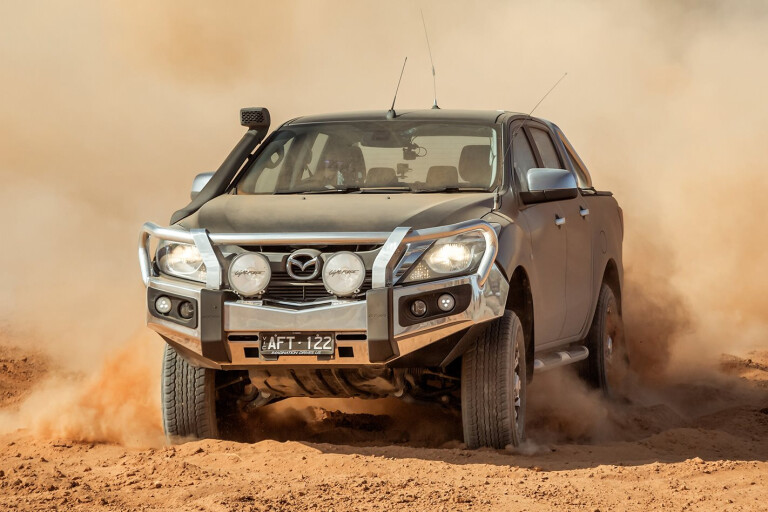
- Introduction: Loaded Rig
- Update 1: Holiday Hustle
- Update 2: Urban Living
- Update 3: Bright Additions
- Update 4: The Big Tow
- Update 5: Conclusion
Second Opinion - Wheels
Introduction: Loaded Rig
It’s been a long spell since we last ran a long-term tester out of 4X4 Australia’s HQ, so we were pretty chuffed to add this ‘new’ Mazda BT-50 to the fleet over summer.
We say ‘new’ because it’s the face-lifted 2015 model, but it did have a few kays on it by the time it reached us here. Mazda used it on its launch program then shipped it to Coober Pedy, where Crafty flogged it around the desert for a few days.
Knowing this car was coming to us, Mazda used it to showcase the extensive range of factory accessories it now offers. It was fitted with an aluminium bullbar, an intake snorkel, a tub mat, floor mats, a dual battery kit, an Icom UHF radio, a towbar and wiring, an electric brake controller, and optional alloy wheels.
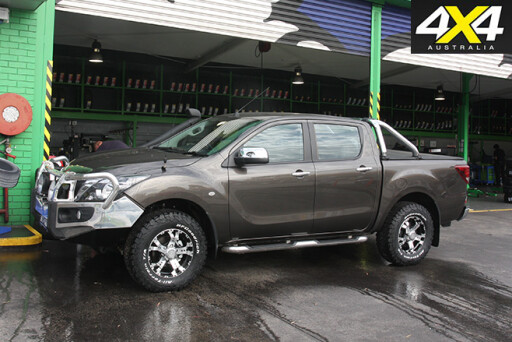 The options crank the price up to more than $63,000, so you could say it’s fully loaded. The $12,000 in extras proves vehicle manufacturers are keen to skim some action away from the aftermarket accessories companies.
The options crank the price up to more than $63,000, so you could say it’s fully loaded. The $12,000 in extras proves vehicle manufacturers are keen to skim some action away from the aftermarket accessories companies.
About the only things Mazda doesn’t offer, and you might want to fit them for outback travel, are a suspension upgrade and heavy-duty tyres. We’re pretty happy with the BT-50’s factory suspension tune, and we quickly fitted a set of BF Goodrich KO2 All Terrains.
We’ve been keen to sample the new BFG ATs since they launched early this year, and now we finally have a ride to trial them on.
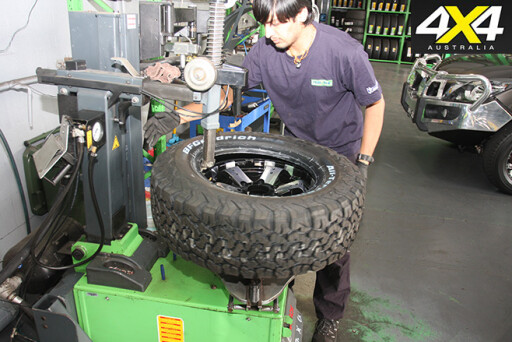 Really impressive are the Australian-developed-and-made products Mazda is offering as factory options. The controller for the dual battery system comes from Redarc, while the driving lights are Lightforce beauties. The factory sat-nav system even has HEMA mapping and OziExplorer loaded on to it, so all bush-track maps are available in the dash.
Really impressive are the Australian-developed-and-made products Mazda is offering as factory options. The controller for the dual battery system comes from Redarc, while the driving lights are Lightforce beauties. The factory sat-nav system even has HEMA mapping and OziExplorer loaded on to it, so all bush-track maps are available in the dash.
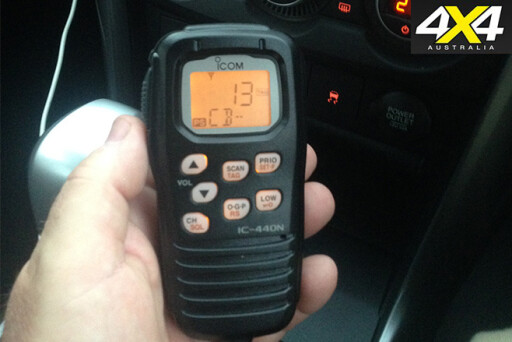 It’s not Australian, but the Icom radio that’s neatly mounted to the console is another well-respected product and, again, it’s great to see Mazda supplying these recognised brands.
It’s not Australian, but the Icom radio that’s neatly mounted to the console is another well-respected product and, again, it’s great to see Mazda supplying these recognised brands.
So far it’s been all highway kays for the Mazda, but we’ll be hitting the dirt and beaches over summer. It has been up the Hume Highway and back and we love the lazy way the five-cylinder diesel engine lopes along the highway, with plenty of grunt to keep the six-speed automatic transmission happy in top gear all day. This, combined with the big-cab feel of the BT, makes it a sweet highway tourer.
 Initial impressions of the BFGs are good, too. They are very quiet for an aggressive AT tyre, but they are still very new. They do show their limits when pushed hard on sealed roads – the deeper-tread blocks, with their square shoulders, protest at being asked to perform like sports car tyres.
Initial impressions of the BFGs are good, too. They are very quiet for an aggressive AT tyre, but they are still very new. They do show their limits when pushed hard on sealed roads – the deeper-tread blocks, with their square shoulders, protest at being asked to perform like sports car tyres.
We’re sure they will be more at home in the dust, gravel and rough stuff.
Accessories
| Tow bar (3.2 utility) | $596.19 |
| Tow ball | $26.83 |
| Trailer wiring harness | $288 |
| Carpet floor mats | $122.84 |
| Tub mat | $410.82 |
| Mobile phone holder | $99 |
| UHF | $869.77 |
| Snorkel | $677.57 |
| Dual battery kit | $1199 |
| Alloy bullbar | $2869 |
| Driving lights | $782.25 |
| Electronic brakes | $515 |
| Soft tonneau cover | $822 |
| Auto lock for tonneau | $459.70 |
| Polished sports bar | $999 |
| 17-inch alloy wheels | $1208 |
| TOTAL | $11,944.97 |
4x4 Shed Log 1: 2016 Mazda BT-50 XTR
Total mileage: 5476km
Date Acquired: November 2015
Price: $63,645
Mileage this month: 1370km
Average fuel consumption: 11.1L/100km
Update 1: Holiday Hustle
The holidays arrived and there was a kitted-out BT-50 sitting in the 4X4 Australia car park. How could we refuse a summer road trip?

The end-of-year holiday period provided the perfect opportunity to put some kilometres on our BT-50, 4X4 Australia’s long-term press car.
As soon as we were dismissed from 4X4 headquarters, we made a beeline up the Newell Highway, headed for the Sunshine State. The loping nature of the relatively large 3.2-litre, five-cylinder diesel engine makes the BT a relaxed highway-mile eater. The gearing in the six-speed auto neatly matches the engine’s torque so that the transmission sits in top gear on the open road, without hunting between gears. This makes the Mazda a more comfortable consideration for long-distance drives, putting less stress on both man and machine.
 Conversely, with the engine ticking along at 2000rpm at highway speeds, it sucks a bit more fuel than some of the newer utes, and the best we could get the average down to was 10.0L/100km on the blacktop. It’s worth mentioning at this point that the car is fitted with slightly taller-than-stock 265/70-17 all-terrain tyres and a bulbar, both of which affect fuel economy, compared to a standard car.
Conversely, with the engine ticking along at 2000rpm at highway speeds, it sucks a bit more fuel than some of the newer utes, and the best we could get the average down to was 10.0L/100km on the blacktop. It’s worth mentioning at this point that the car is fitted with slightly taller-than-stock 265/70-17 all-terrain tyres and a bulbar, both of which affect fuel economy, compared to a standard car.
After a couple of thousand road miles, we left the blacktop for the dusty tracks of the New South Wales’ Snowies, and crossed the border back into Victoria, over the Alps. It’s always pleasing to drop the tyre pressures down for the steep off-road tracks of the High Country, and this adventure didn’t disappoint.
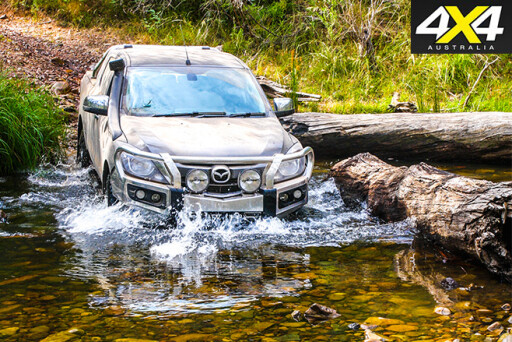 Steep rutted tracks posed no problem for the torquey BT, and when a bit of surety was needed for wet climbs, the rear locker was easily employed. The BF Goodrich KO2 A/Ts really came into their own in the High Country. Rocks, ruts, mud and dust were easily dispatched from the deep tread, and after clocking up close to 5000km, there were no signs of chipping or cuts in the tyres.
Steep rutted tracks posed no problem for the torquey BT, and when a bit of surety was needed for wet climbs, the rear locker was easily employed. The BF Goodrich KO2 A/Ts really came into their own in the High Country. Rocks, ruts, mud and dust were easily dispatched from the deep tread, and after clocking up close to 5000km, there were no signs of chipping or cuts in the tyres.
There were, however, a few little annoyances only noticeable after living with the BT for some time. First, there isn’t a lot of information available on the trip computer, and to scroll through the menu you need to reach through the steering wheel to push the button on the dash binnacle; a simple task like checking the outside temperature (when the menu is showing fuel consumption) means you have to reach through the wheel, instead of being able to simply push a button on the wheel.

Also, there’s only one USB port in the front of the car and it’s in the glove box, meaning if you want to plug in your phone, you need to do it on that side of the car – you can’t do it from the driver’s seat.
A big annoyance – and this one gets me every time I drive the BT-50 – is that although Mazda did a bang-up job of redesigning the dash for the 2016 upgrade, introducing a nice, big AV screen in the middle of it, and a reversing camera (standard in the XTR-spec that we have), the two of them aren’t linked and the image from the camera appears on a tiny, glare-affected panel in the rear view mirror.
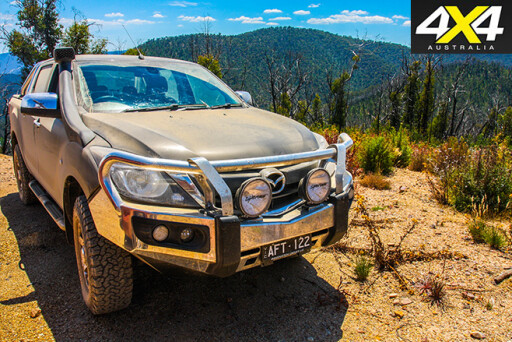 That means you need to use your hand to shield it from light whenever you are backing up. It’s stupid and annoying!
That means you need to use your hand to shield it from light whenever you are backing up. It’s stupid and annoying!
These are small blemishes on the BT-50’s otherwise polished performance, and they’re outweighed by the driveability, comfort and all-terrain ability of a great all-round package.
4x4 Shed Log 2: 2016 Mazda BT-50 XTR
Total mileage: 10,575km
Mileage this month: 5099km
Average fuel consumption: 10.4L/100km
Update 2: Urban Living
Only after you’ve driven a car for some time do all the downsides become clear. But with the Mazda BT-50, the good still outweighs the bad
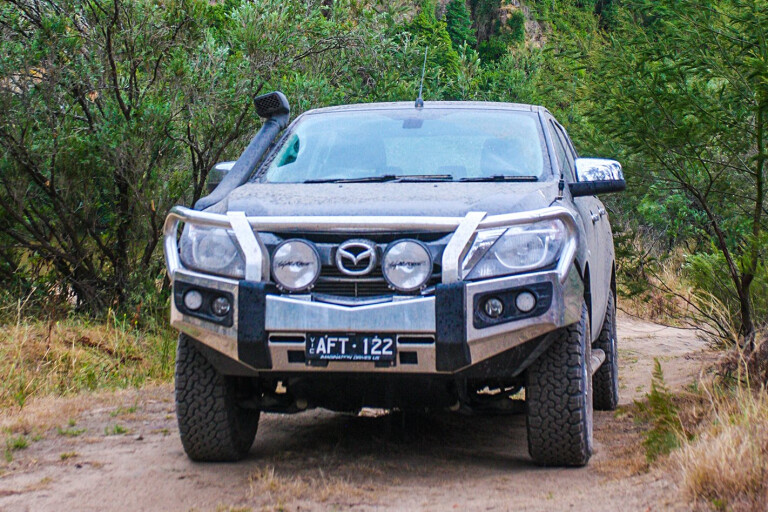
They say you’ll never know how many friends you have until you own a ute, a car trailer, or both.
We proved that theory when one of our associates at MOTOR magazine spotted our BT50 in the carpark at a time when he was moving house. The timing was right for us, as we had five wagons on test for this issue, and so the BT was available for furniture-shifting duties, a task it handled with ease.
We also used the time we had the wagons at hand to get a 10,000km service done on the BT50, a relatively basic, routine service.
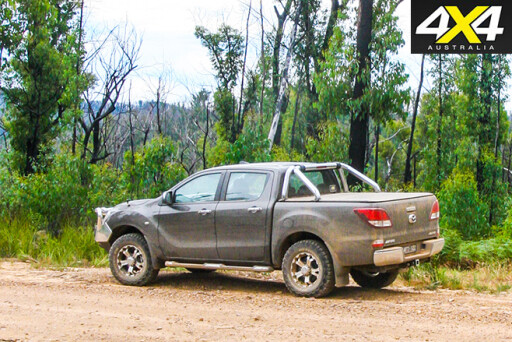 We had one fault to ask the service department at Brighton Mazda to attend to – a niggling rattle from under the car that has been there since we took delivery of the vehicle. It is a tinny rattle that can be heard at idle from outside the car and sounds like it’s coming from an exhaust heat shield or something similar.
We had one fault to ask the service department at Brighton Mazda to attend to – a niggling rattle from under the car that has been there since we took delivery of the vehicle. It is a tinny rattle that can be heard at idle from outside the car and sounds like it’s coming from an exhaust heat shield or something similar.
This seems likely after the trip the Mazda did in Central Australia before we got it. Despite the rattle being easily audible from outside the car, the technicians at Brighton were unable to find its cause.
Maybe times have changed, but when I worked in the workshop of a new car dealer, if a mechanic tried to send out a car with such a rattle, the foreman or road tester would have kicked his arse, whether the car owner had noted the problem or not.
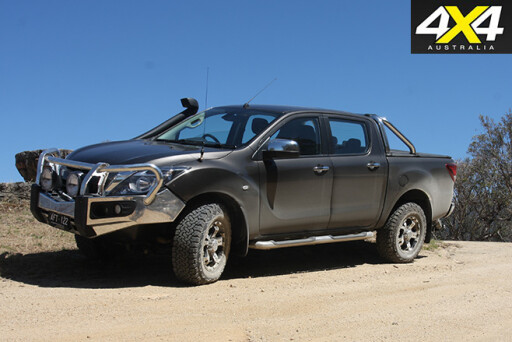 Aside from these happenings, the BT has been serving commuter duty, which it has done without trouble or complaint. You just need to be wary of the big ute’s size when parking in suburbia, a task that isn’t helped by the fact the reversing camera image is in the rear-view mirror and not the in-dash screen.
Aside from these happenings, the BT has been serving commuter duty, which it has done without trouble or complaint. You just need to be wary of the big ute’s size when parking in suburbia, a task that isn’t helped by the fact the reversing camera image is in the rear-view mirror and not the in-dash screen.
While we’re mentioning the screen, it’s great for sat-nav on and off road but is almost impossible to see in daylight, requiring you to shield it by hand to get a handle on what’s on screen. I don’t know if it’s the material used for the screen or simply that the angle of it catches the sun, but it’s a crook design.
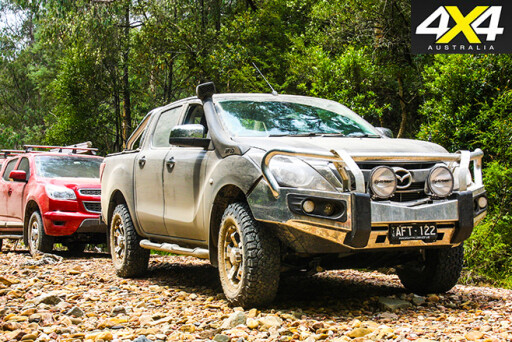 First world problems, I know. It’s lucky such problems are offset by the great size and performance of the BT.
First world problems, I know. It’s lucky such problems are offset by the great size and performance of the BT.
4x4 Shed Log 3: 2016 Mazda BT-50 XTR
Total mileage: 11,502km
Mileage this month: 927km
Average fuel consumption: 11.2L/100km
Update 3: Bright Additions
Our resident BT-50 scores some high-class driving lights from Lightforce.
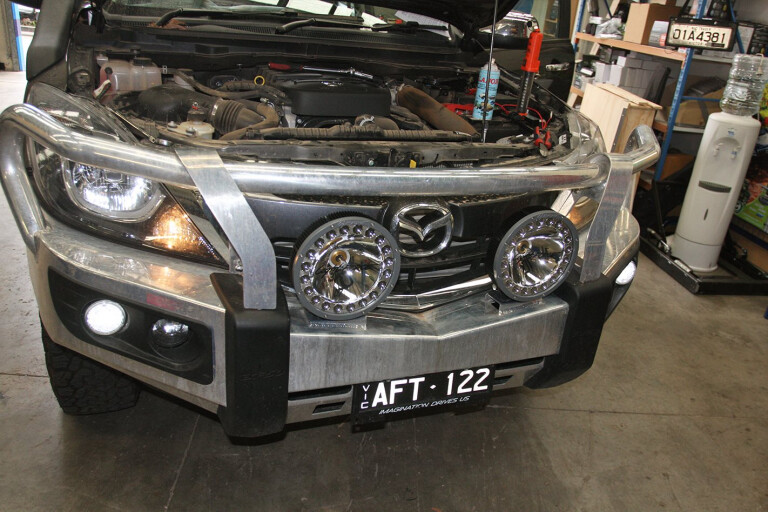
Our BT-50 has been out on loan again, this time with the crew from Trade-a-Boat magazine who had a fishing trip to some coastal location.
They only just got back, but they reported the Mazda towed the 2.5-tonne boat up through Gippsland with ease, in comfort and remained economical. If only the fishing was that good, hey guys? More on that next month.
Before the boaties took it away we couldn’t resist fitting a set of Lightforce’s new DL230HTX driving lights to the bullbar. The BT came with a set of Lightforce Genesis spotties, which are great lights.
 Mazda should be commended for offering such top quality products as a genuine accessory. And it’s an Australian product, too! But these HTX lights are the next level up.
Mazda should be commended for offering such top quality products as a genuine accessory. And it’s an Australian product, too! But these HTX lights are the next level up.
The HTX combines the broad beam lighting of an LED lightbar with the far-reaching beam of HID lights. The 20 LED chips are wrapped around the 70-watt HID light, so there’s no need to have both round lights plus a lightbar on the front of your car.
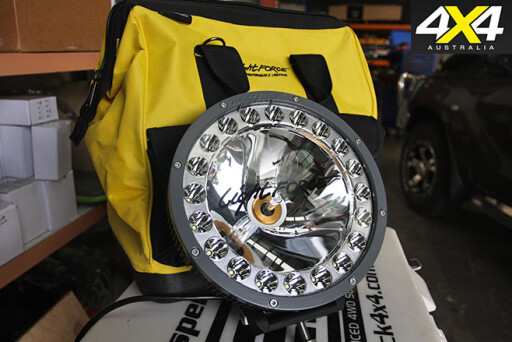 You can even run either the LEDs or the HIDs on their own, or switch them on together for the ultimate performance. Initial impressions are that the lights are amazing, but we’ll have a more extensive test of the Australian-made lights soon.
You can even run either the LEDs or the HIDs on their own, or switch them on together for the ultimate performance. Initial impressions are that the lights are amazing, but we’ll have a more extensive test of the Australian-made lights soon.
The lights were fitted by our good mate and local Lightforce distributor Phil Cochrane down at Ontrack Automotive in Ferntree Gully. Phil did the EFS suspension upgrade on our project HiLux give-away (March, 2016) and knows his stuff, so we had no qualms letting him loose on the Mazda BT-50. Fitting lights posed no challenge for him.
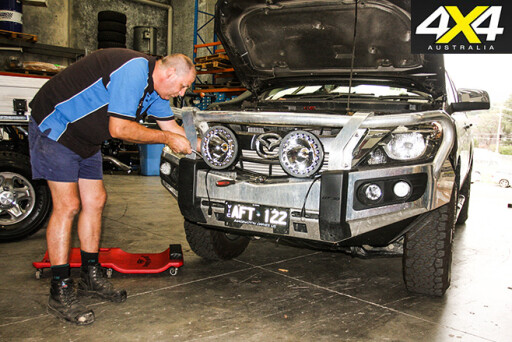 Around town the BT continues to be a great commuter. Ideal for chucking the BMX in the back to get away for rides, hitting the 4x4 tracks on quick weekend drives and just getting about the city. The versatility of a double-cab ute is unmatched and the Mazda, with its relatively big 3.2-litre diesel engine and six-speeed auto, provides a great balance of performance and economy.
Around town the BT continues to be a great commuter. Ideal for chucking the BMX in the back to get away for rides, hitting the 4x4 tracks on quick weekend drives and just getting about the city. The versatility of a double-cab ute is unmatched and the Mazda, with its relatively big 3.2-litre diesel engine and six-speeed auto, provides a great balance of performance and economy.
4x4 Shed Log 4: 2016 Mazda BT-50 XTR
Total mileage: 13,647km
Mileage this month: 2145km
Average fuel consumption: 10.9L/100km
Update 4: The Big Tow
The BT-50 has been pulling boats and lighting up the bush.
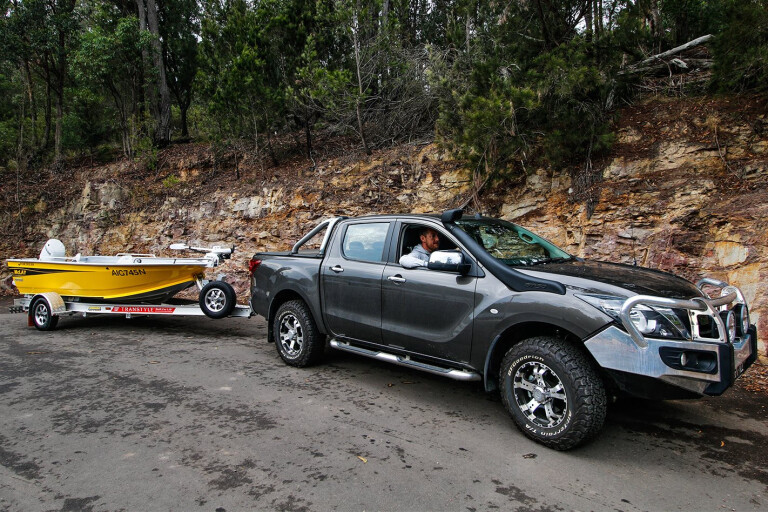
LAST month we mentioned the guys from Trade-a-Boat magazine borrowed our Mazda to pull some boats on a fishing trip, and they’ve since sent us some pics that show just what they were hauling.
No wonder they said it towed them with ease. The Mazda’s 3.2-litre five-cylinder diesel would have made light work of those little boats and probably could have pulled them both together without raising a sweat. All the same, it’s good to know that the boaties thought it a good thing for towing.
We also took the BT out for a night-run through Wombat and Lerderderg State Forests, with the crew from the Werribee District 4WD Club. We hit the tracks after a cracker meal at the Blackwood Hotel, and this gave us the chance to give the Lightforce HTX lights a burl.
 The HTXs employ a HID spot beam and an LED broad beam, and we found the LEDs to be the real winners in these scrubby conditions. The light colour is easy on the eyes and provides nice definition to the areas around the front of the car.
The HTXs employ a HID spot beam and an LED broad beam, and we found the LEDs to be the real winners in these scrubby conditions. The light colour is easy on the eyes and provides nice definition to the areas around the front of the car.
On the highway, the HIDs punch out way ahead of the car and are better-suited to this sort of driving, but ours need to be adjusted to get better results. We didn’t have the right tools for the job at the time, so we’ll have to see to that later.
The Mazda again showed its ease of use on bush tracks, and we did most of them in high-range 4x4 to let the 3.2 just lope along at an easy pace. Low range and a bit more throttle were used a couple of times for the steeper stuff, but it was relatively easy going on this night. We passed on the more challenging tracks, as our stock-ride-height BT would have scraped to a stop in the axle-deep ruts, but otherwise it was never challenged for traction.
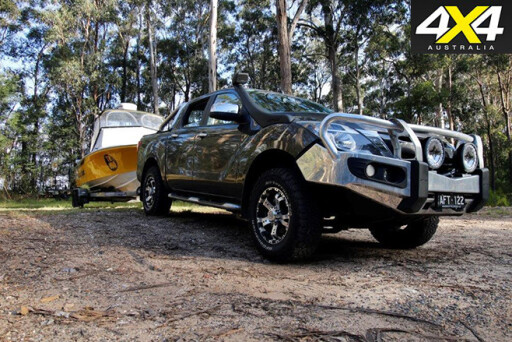 Our Mazda has HEMA maps installed to provide more details of the bush tracks in this area. This is an option on the BT-50 and one well worth the money if you like to get off the beaten track. As far as we know, Mazda is the only company that offers this great Australian mapping product.
Our Mazda has HEMA maps installed to provide more details of the bush tracks in this area. This is an option on the BT-50 and one well worth the money if you like to get off the beaten track. As far as we know, Mazda is the only company that offers this great Australian mapping product.
Getting out with the Werribee District 4WD Club was a lot of fun and showed us another way that a vehicle like the BT-50 can be used to get out and enjoy the bush. It was as much a social night as anything, and the genuine-accessories Icom UHF fitted by Mazda was buzzing with chatter all night. Thanks to the Werribee District 4WD Club for the invite.
Following our comments last month about the rattle from under the BT, Mazda took the car away and replaced the muffler that had lose internals. Problem fixed. We don’t know why the dealer couldn’t have done that.
4x4 Shed Log 5: 2016 Mazda BT-50 XTR
Total mileage: 14,984km
Mileage this month: 1337km
Average fuel consumption: 10.9L/100km
Update 5: Conclusion
Our six months with the BT-50 draws to a close, but are we sad to see it go?
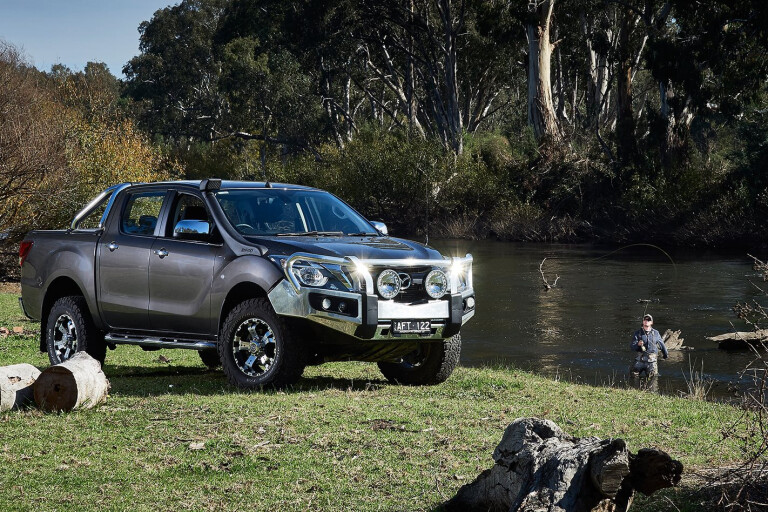
TIME flies when you’re having fun, and it’s been fun having the BT-50 here. Yep, its six months with us are up and it will be sad to see it go. The BT-50 has proven to be a versatile and practical vehicle for all sorts of motoring, and it has certainly lived up to its role as a dual-purpose 4x4.
The BT came to us fresh off the back of a trip to Coober Pedy and Oodnadatta, where former editor Marcus Craft put it through its paces on the rocky and dusty tracks out there. Mazda gave it a good tidy up before we picked it up in Melbourne, but when we dropped the spare tyre down to fit the BFGoodrich All Terrain KO2s, the gravel and red dust that dropped off with it revealed where the car had been.
The BFG KO2s were the only aftermarket item we needed to fit thanks to the crew at Mazda ticking off all the essentials from its factory accessories catalogue. This proved to be a real bonus, as the car came ready for action wherever we wanted to take it. The gear from Mazda was all top quality, including Lightforce Genesis driving lights, an Icom UHF radio, HEMA mapping on the sat-nav and the Redarc dual-battery system. All this gear proved invaluable out in the bush and, coming from reputable brands, we could be confident they wouldn’t let us down. Top marks to Mazda for offering such quality accessories.
 With the BFGs on the BT, we took off from Melbourne for an interstate trip to Queensland using some out of the way backroads to break up the trip. The return was at a much more leisurely pace, as we beach-hopped down the coast as far as Newcastle and then cut for the Snowy Mountains to follow the Snowy River from its source to the coast.
With the BFGs on the BT, we took off from Melbourne for an interstate trip to Queensland using some out of the way backroads to break up the trip. The return was at a much more leisurely pace, as we beach-hopped down the coast as far as Newcastle and then cut for the Snowy Mountains to follow the Snowy River from its source to the coast.
We love the way the Mazda has a relaxed touring gait on the highway; the torquey 3.2-litre engine pokes along without raising a sweat and then hardens-up when on the steep slopes of the high country, which it handles with ease.
Since that trip the BT has done general day-to-day commuter duties, helped a mate move house, carried pushbikes to the tracks, day trips with 4x4 clubs, towed boats on fishing trips with our mates at Trade-a-Boat magazine and, most recently, snuck off for a day of fly-fishing with Mick and James from Mountain Fly, Victoria. The BT does all these things with ease, confidence and, most importantly, it has never let us down.
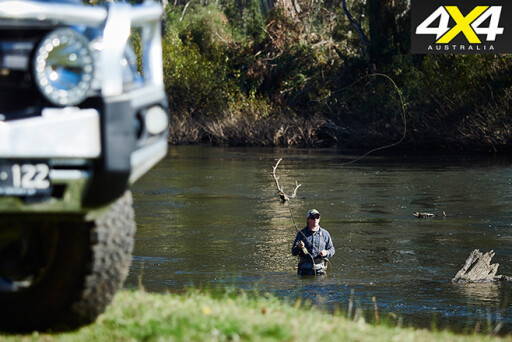 The only problem we had with the car was a rattle from the muffler, which was replaced by Mazda at service time and wasn’t a major issue.
The only problem we had with the car was a rattle from the muffler, which was replaced by Mazda at service time and wasn’t a major issue.
As I said, I’ll be sad to see the BT go as it really showed the advantages of having a dual-cab 4x4 ute that’ll do just about anything you throw at it.
WHAT WE LOVED
- Big, spacious cabin with quality fit-and-finish
- Torquey engine that’s great on- and off-road.
- Quality aftermarket options from Mazda.
- Do-it-all ability.
ROOM FOR IMPROVEMENT
- Rear-view camera image should come up in big dash screen.
- Dash menus not selectable from steering wheel.
- Missing voice command to utilise Bluetooth.
4x4 Shed Log 6: 2016 Mazda BT-50 XTR
Total mileage: 14,984km
Date Acquired: November 2015
Price: $63,645 (incl. extras)
Mileage this month: 1766km
Average fuel consumption: 11.2L/100km
Sign-up here to get the best 4x4 stories of the week - FREE!
SECOND OPINION - WHEELS (By: Toby Hagon)
Introduction: Finke Finesse
Wheels' BT-50 Finke race ute takes shape. But first it has a few domestic duties to take care of.
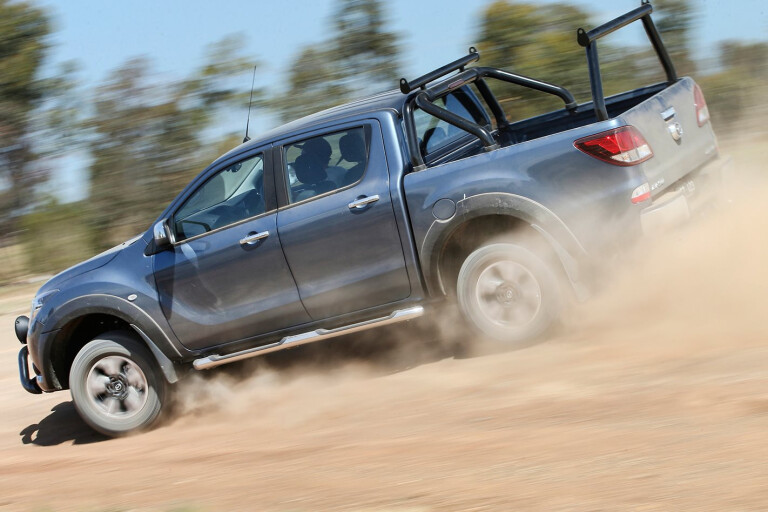
HERE’S something we’ve never done before at Wheels – lived with a dual-cab ute as a long-termer. Separate chassis, live rear axle and a workhorse diesel engine are the order of the day for our Mazda BT-50.
Truth is, though, it’s getting difficult to ignore the ute market. The vehicles once confined to farm paddocks or tradies’ driveways now account for almost one in six new-vehicle sales. That’s big business, and there’s been a big shift in the ute market’s landscape. A sizeable chunk of it is devoted to top-end utes where the price tag exceeds $60,000. And it’s the diesel dual-cab off-roaders leading the charge: 4x4 models outsell two-wheel drives by more than three to one.
Yet most people are using them as on-roaders, with only occasional off-road use.
 And performance-focused utes are coming; AMG is set to tweak the upcoming Mercedes-Benz ute, Ford is planning a Ranger Raptor, Nissan is considering a Nismo Navara and Toyota is looking at a Hilux TRD. In the shorter term Volkswagen will bring V6 diesel performance back to the workhorse segment with an update to the Amarok arriving late in 2016.
And performance-focused utes are coming; AMG is set to tweak the upcoming Mercedes-Benz ute, Ford is planning a Ranger Raptor, Nissan is considering a Nismo Navara and Toyota is looking at a Hilux TRD. In the shorter term Volkswagen will bring V6 diesel performance back to the workhorse segment with an update to the Amarok arriving late in 2016.
Besides, the plan from the start of our few months with a BT-50 was to put it through more than any ute before it. As well as thousands of kilometres of suburban and country punishment – where we plan to push the BT-50 XTR to its limits – this is the car we’re taking in the punishing Finke Desert Race.
It’s claimed to be one of the most challenging off-road races in Australia. We’ll be entering the car in the Production 4WD class, where modifications are limited to suspension changes and engine tweaks. And, of course, safety systems and protection for mechanical components.
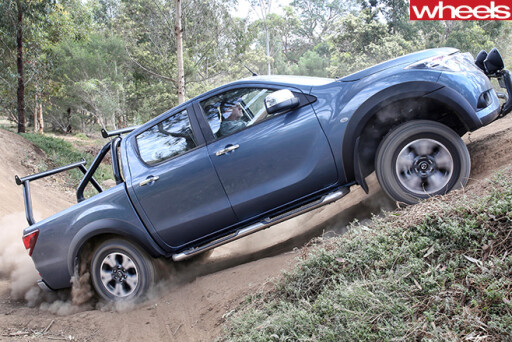 Our mods will be minimal. We’ll be getting some more serious shock absorbers to better deal with the jumps and corrugations so common on the Finke track, which is 230km long and heads south from Alice Springs to the Aboriginal community of Finke. The 3.2-litre five-cylinder turbo diesel engine will be unchanged and the only interior changes will be to meet the event regulations (that means we get to keep the factory air-conditioning – woohoo!).
Our mods will be minimal. We’ll be getting some more serious shock absorbers to better deal with the jumps and corrugations so common on the Finke track, which is 230km long and heads south from Alice Springs to the Aboriginal community of Finke. The 3.2-litre five-cylinder turbo diesel engine will be unchanged and the only interior changes will be to meet the event regulations (that means we get to keep the factory air-conditioning – woohoo!).
But since January our racer-in-waiting has been put to work. It’s been all about making the best use of its design.
Our BT-50 arrived with some 7500km on the clock and was put straight to work on the school run. As with all utes, fitting a child seat takes some fancy finger work to attach the top tether point from the child seat to the anchor between the seat back and the rear of the cabin.
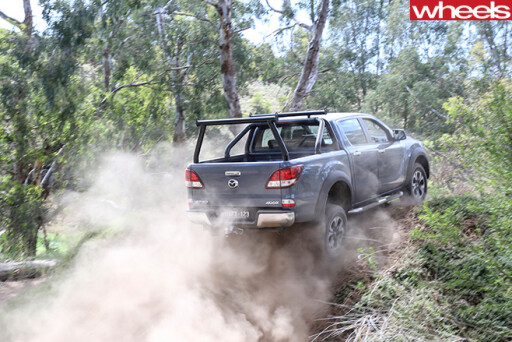 No complaints from the children once in place, though. Turns out they love utes, to the point where it took a while to convince my four-year-old that he could only play in the tray when it was parked.
No complaints from the children once in place, though. Turns out they love utes, to the point where it took a while to convince my four-year-old that he could only play in the tray when it was parked.
Beach runs, too, are a snip, with boogie boards and sandy towels thrown straight in the tray. The occasional hose-out is all it needs to stay sparkling (well, as sparkling as I want it...).
And family bike rides are so much easier. All four bikes can fit in the back, with the ladder rack coming in handy for slinging the wheels of the bigger bikes over.
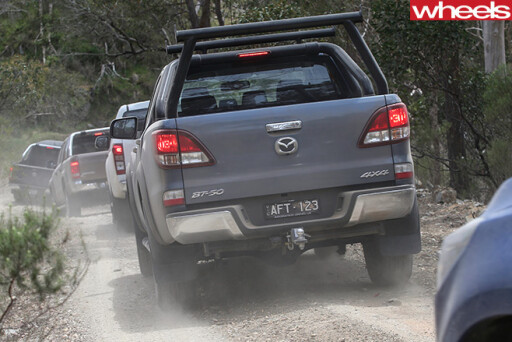 In its first couple of months, AFT 123 also headed on a country cruise. Again, it was gear in the back and a family of four on board for the 1100km round trip.
In its first couple of months, AFT 123 also headed on a country cruise. Again, it was gear in the back and a family of four on board for the 1100km round trip.
Fuel use early on is reasonable, at 9.6 litres per 100km – and most of the time it’s anything but babied. I figure if this thing is going to race we may as well get it used to the punishment. And with that sort of fuel use it means it’ll comfortably go the distance at Finke.
The extras
Our BT-50 has already had plenty of options thrown at it. The most obvious are the front nudge bar with driving lights (great for blaring idiots) and the ladder rack on the rear, which allows long items to be strung to the sports bar just behind the cabin; the lights and nudge bar will stay for our Finke adventure, but the ladder rack will be ditched. There are also dual 12-volt power sockets and a spongy tray liner to reduce damage when launching things in the back. And the near obligatory tow bar.
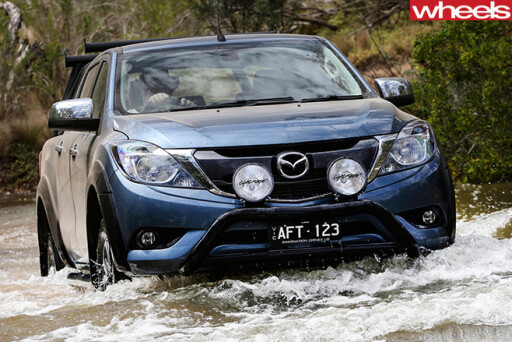 Mazda v Ford
Mazda v Ford
The current shape BT-50 went on sale in 2011. It is produced in the same Thai factory as the Ford Ranger and shares many components with that car, including windows, the basic chassis and engine. However each has unique exterior bodywork, including the doors (often shared between models that otherwise share so much). An update in 2015 tried to straighten the toothy grin and make the tail less polarising, but it drives identically to that 2011 car (Mazda opted not to tweak the engine and dynamics, as Ford did with the Ranger).
Model range
Our XTR model sits in the middle of the BT-50 family and is one of the more popular models. There’s also a GT model above it that gets tinted windows, leather seats and an electrically operated driver’s seat. Sure, those extras would be great for on-road comfort, but they’re of little use on the Finke.
Mazda BT-50 XTR long-term details:
Date acquired: February 2016
Price: $51,700
Mileage this month: 1380km @ 9.6L/100km
Odometer: 8980km
Overall: 1380km @ 9.6L/100km
Update 1: Conclusion
Toby Hagon continues his shakedown of the Team Wheels Finke Desert Race Mazda BT-50 XTR ute.
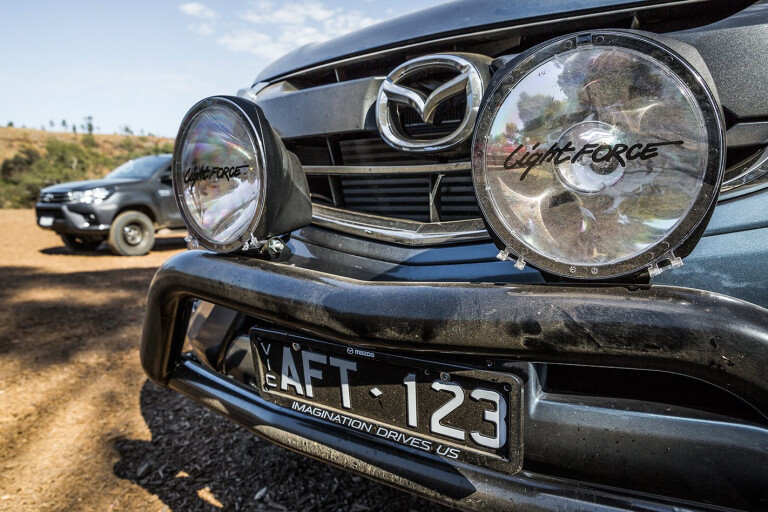
A couple of months in and I’m getting used to a ute. Being able to launch pretty much anything into the tray is a surprisingly big bonus. I’ve had everything from a pile of wood to mountain bikes and kids toys in the back of AFT 123, the Team Wheels car that will be taking part in the Finke Desert Race over the Queen’s birthday long weekend.
A hundred or so kilos in the back works surprisingly well, too. It helps settle the stiffness that can make for an otherwise jumpy ride on second-grade roads. That’s good news for our Finke challenge. The 230km course south of Alice Springs is known for its bumps and jumps, and because we’ll have extra gear on board – spare tyres, a basic tool kit and the weight of a roll cage – it’s comforting to know the suspension is up to some punishment.
I’ve also been keeping an eye on traction when accelerating. On a slippery surface – fair chance the Finke’s red dirt will be slippery – the inside rear can try to wheelspin, waking the traction control. So four-wheel drive will be the pick for the lumps and bumps of the Finke course.
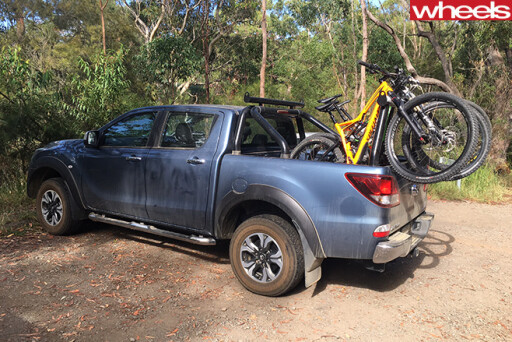 Not that I’m getting too used to AFT 123. My car was also summoned back from me to get prepped for the Big Race. A roll cage, race seats and stickers are the main changes. Plus we also need a few weeks to truck it to Alice Springs, along with our fleet of support cars.
Not that I’m getting too used to AFT 123. My car was also summoned back from me to get prepped for the Big Race. A roll cage, race seats and stickers are the main changes. Plus we also need a few weeks to truck it to Alice Springs, along with our fleet of support cars.
But there was another BT-50 in the wings: AFT 124. It misses out on some of the previous car’s extras – including the nudge bar – but picks up the rolling hard canopy. It’s a fancy way to cover the ute tray and looks the business, although it shortens the tray by about a foot.
That’s enough to make it more difficult to fit in a 29-inch mountain bike, something my previous BT had been subjected to plenty of times. Still, some careful negotiation of the front wheel and it slots in no probs.
Under the bonnet, the 3.2-litre five-cylinder turbo diesel is as grunty as ever, something that comes in handy for shifting what is a sizeable machine. Even better is that performance barely changes once you load it up with people and some gear.
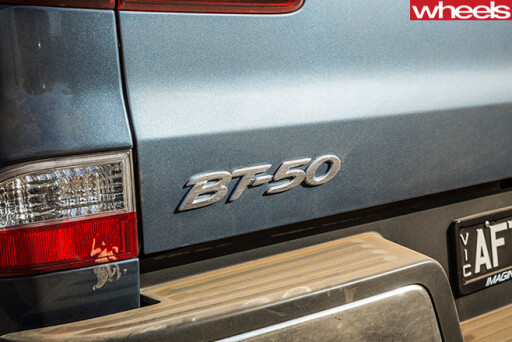 Perfect for off-road racing! We also don’t have to worry about fuel use; the BT-50’s claimed average fuel use is 9.2 litres per 100km, and I’ve been getting close to that – albeit with a decent country cruise as part of the driving mix. Even when thrashing it, I reckon we’ll use something like 12 or 13L/100km, which bodes well for the Finke challenge (the 80-litre fuel tank will comfortably do the 226km distance each day).
Perfect for off-road racing! We also don’t have to worry about fuel use; the BT-50’s claimed average fuel use is 9.2 litres per 100km, and I’ve been getting close to that – albeit with a decent country cruise as part of the driving mix. Even when thrashing it, I reckon we’ll use something like 12 or 13L/100km, which bodes well for the Finke challenge (the 80-litre fuel tank will comfortably do the 226km distance each day).
As for the transmission, the six-speed auto is an honest unit. It’s ironic that Mazda’s least sporty model gets the best set up for selecting the Sports mode on the transmissions. Whereas the MX-5, Mazda 6 and others call on you to flick the sports button south of the gear selector, the BT-50 is a simple push of the gear lever towards the driver. Blame that on the Ford influence.
The BT-50 has lost me on one count, though; its USB plug is buried in the glovebox, making it difficult to access on the run. I’m also not sold on the reversing camera, which displays on a small screen within the rear vision mirror rather than the 7.8-inch screen in the dashboard.
The rest of the interior is simple but well done. The circular climate control knobs, for example, are easy to operate on the run, and there’s loads of storage, including a pod atop the dash and underseat storage in the rear.
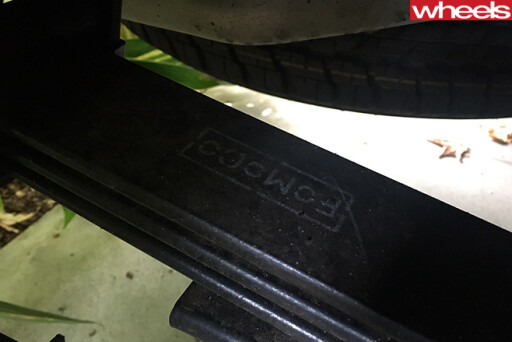 Haven’t we met before?
Haven’t we met before?
There’s no hiding the Ford roots of the BT-50. In the corner of each window is a FoMoCo stamp, signifying it’s a product of the Ford Motor Company. The same stamp is on the rear leaf springs, too. And when you pop the bonnet, while it’s the stylised Mazda M logo that’s prominent in the centre of the engine cover, you don’t have to look too far to spot FoMoCo stamps on pipes and other components.
That’s because the BT-50 was developed in conjunction with the Ford Ranger and comes out of Ford’s Thai factory.
Yet despite the major component sharing – something increasingly common across brands and models these days – it’s been done cleverly enough to ensure each has its own identity. The interiors, for example, share some design themes, but are presented differently. And the exterior panels are unique to each model.
Mazda BT-50 XTR long-term details:
Date acquired: February 2016
Price: $51,700
Mileage this month: 510km @ 9.8L/100km
Odometer: 8980km (for AFT 123), 6385km (for AFT 124)
Overall: 1890km @ 9.7L/100km
Follow the journey of Wheels' BT-50 XTR at the 2016 Finke Desert Race
- Prepping the BT-50
- All Finked out



COMMENTS